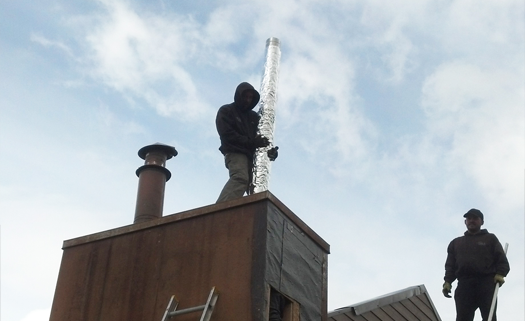

Big Sky Chimney installs insulated chimney liners for wood burning inserts, wood stoves, and fireplaces in accordance to the manufacturers specifications while also complying with NFPA
211 Standards. Not all liners are required to be insulated, however the benefits outweigh the cost to insulate. Installing an insulated chimney liner does cost more for the installation, but it also provides you with a cleaner,
more efficient burn. It's also safer because an insulated chimney liner will typically have less than half the build up of creosote/soot after one season of burning. Inert owners with un-insulated chimney liners have their chimney
swept twice every winter season costing them significantly more over time to maintain their wood burning system. A couple years of additional chimney cleaning costs from not having an insulated chimney liner could have
paid for an insulated chimney liner offering you and your neighbors a cleaner burn while paying for less frequent chimney sweep services.
Chimney liners serve three main functions:
1.) Protecting the house from heat transfer to combustibles.
In the NBS tests, unlined chimneys allowed heat to move through the chimney so rapidly that the adjacent woodwork caught fire in only 3 1/2
hours.
2.) Protecting the masonry from the corrosive byproducts of combustion.
In the tests it was determined that if the flue gases were allowed to penetrate to the brick and mortar, the
result would be a reduction in the usable life of the chimney. The flue gases are acidic in nature and literally eat away at the mortar joints from inside the chimney. As the mortar joints erode, heat transfers more rapidly to the nearby
combustibles and dangerous gases such as carbon monoxide can leak into the living areas of the home.
3.) Providing a correctly sized flue for optimum efficiency of appliances.
Modern wood
stoves and gas or oil furnaces require a correctly sized flue to perform properly. The chimney is responsible for not only allowing the products of combustion a passage out of the house, but the draft generated by the chimney also
supplies the combustion air to the appliance. An incorrectly sized liner can lead to excessive creosote buildup in wood-burning stoves, and the production of carbon monoxide with conventional fuels.
Types of chimney liners:
Clay tiles are the most common type of masonry chimney liners.
Advantages: They are inexpensive, readily
available, and perform quite well for open fireplace chimneys that are properly maintained.
Disadvantages: They cannot rapidly absorb and evenly distribute heat during the rapid temperature rise that
occurs during a chimney fire, causing the flue tiles to crack and split apart (see the video - below). The second disadvantage is that tiles cannot adequately contain the liquid combustion byproducts produced by modern gas
appliances.
Metal chimney liners
Advantages: If properly installed and maintained, metal chimney liners are extremely safe and durable. Stainless steel is
suitable for wood-burning, gas, or oil appliances, while the aluminum is an inexpensive alternative for certain medium efficiency gas applications only. It is usually required that high temperature insulation be used in conjunction with
the liners for safety and performance considerations.
Disadvantage:
Considerably more expensive than clay flue liners.
National Chimney offers a line of metal chimney liners that have been
accepted by CSIA as safe for home use when properly installed.
Cast-in-place chimney liners
Advantage:
They can improve the structural integrity of aging
chimneys, and are permanent liners suitable for all fuels.
Disadvantage:
Considering the dangers of old unlined or damaged chimneys, and the many cost effective options now available to make these
chimneys safe components of the home heating system, we encourage you to have your chimney professionally inspected by a local CSIA Certified Chimney Sweep an an annual basis to be sure it meets modern safety standards.